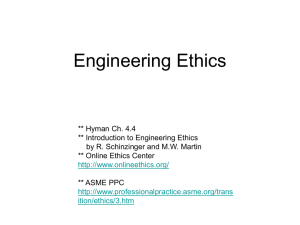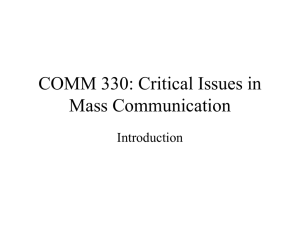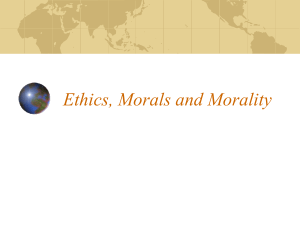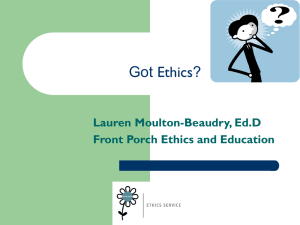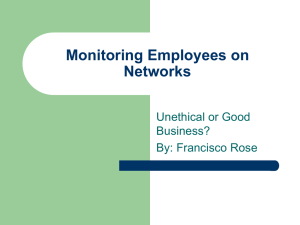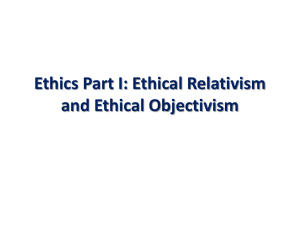Ethics, Law and Advocacy - California State University, Long Beach
advertisement
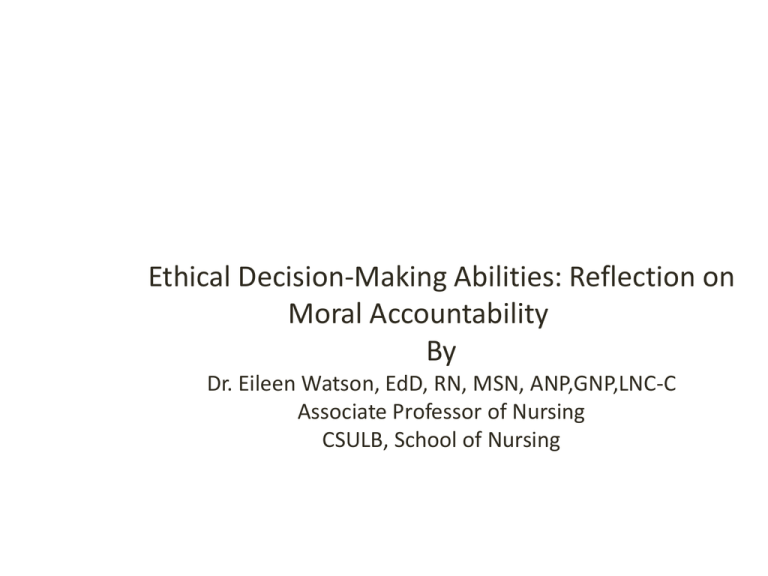
Ethical Decision-Making Abilities: Reflection on Moral Accountability By Dr. Eileen Watson, EdD, RN, MSN, ANP,GNP,LNC-C Associate Professor of Nursing CSULB, School of Nursing 1 Purposes of Module 1. To increase the student nurse’s knowledge of the distinction between ethics and law, ethical theories and principles 2. To assess one’s moral attitudes, beliefs, and values 3. To increase the student nurse’s knowledge of current ethical issues occurring in clinical practice settings 4. To promote the development of student nurse’ skills in ethical decision-making, moral reasoning, moral judgment and ethical reflection 5. To examine Professional Code of Ethics 2 Module Objectives Upon completion of this learning module with its assigned readings and learning activities, the student nurse will be able to: 1. 1. Define the terms: ethics, morals, attitudes, beliefs, values, ethical dilemma, and moral accountability 2. Discuss Kohlberg’s (1971) Theory/Stages of Moral Development 3. Differentiate ethical theories of deontology, teleology, and principalism 3 Module Objectives cont. 4. Apply to nursing practice eight ethical principles 5. Identify the nine provisions and the key interpretive statements for each provision of the American Nurses Association (ANA) Code of Ethics for Nurses With Interpretive Statements (2001) and discuss how each provision may effect the practice of nursing 6. Identify ethical issues frequently seen in clinical settings 4 Module Objectives cont. 7. Identify symptoms of moral distress experienced by nurses in clinical practice 8. Identify moral distress activity sources in clinical practice and academic settings 9. Identify negative impacts in health care work environments caused by moral distress 10. Analyze the MORAL model in ethical decision-making 11. Discuss the pros and cons of selected ethical issues such as medical futility, foregoing nutrition and hydration, social justice, abortion, active euthanasia, and assisted suicide 5 Module Objectives cont. 12. Identify California state laws associated with selected ethical issues in objective #11, if applicable 13.Guided by the influence of one’s personal values, professional codes, and patient care preferences, debate the legal and ethical principles in the analysis of selected ethical issues in objective #11 14. Discuss ANA’s Position on Ethics and Human Rights 6 Definition of Terms • Ethics: branch of philosophy that examines the moral value of human conduct. Source is internal to oneself • Values: personal beliefs about truth, thoughts, action, or objects • Values Clarification; “a process aimed at understanding the nature of one’s own value system and its vast impact on the individual” (Guido, 2010, p. 3). Why is this important to nursing? • Value Systems: personal, professional, societal • Ref. Guido, 2010, Ch.1 7 emw 7 Definition of Terms cont. • Ethical Dilemma: when an individual must choose between two equally unfavorable alternatives. Occurs when there is conflict between 2 or more ethical principles and there is no obvious “right” decision (Kelly, 2010). Jameton (1984)—Initial dimension and reactive dimension. Personal values and professional experiences influence attitudes of nurses when pondering ethical dilemmas (Winland-Brown & Dobrin, 2009) • Ethical Reflection: Schon (1967). Reflection on Action • Nursing Code of Ethics: Defines the profession’s values and standards of conduct 8 Definition of Terms cont. • Morals: are personal principles • Morality: is one’s exhibited behavior influenced by personal principles • Moral Distress: occurs when a situation involves conflict between 2 ethical principles • Moral Reasoning: is thinking and reasoning about what one ought to do based on ones morality • Moral Judgment: a decision to act or not act based on what an individual believes is good/bad—right or wrong • Moral Accountability: Being responsible for one’s actions== (Duty To Oneself) Ref. Guido (2010) Ch. 1 and 2 9 Symptoms of Moral Distress • Physical: headaches, tiredness, gastrointestinal symptoms, shaking, pain • Psychological: feelings of guilt, anxiety, frustration, anguish, confusion • Ref. Ganske (2010), p. 3 10 Moral Distress Activity Sources For Nurses, Administration, Educators and/or Students Clinical Practice Settings • Nonsupportive/nonrespectful ethical climate • Nurses core personal values and ethical obligations conflict • End-of-life situations • Protection of patient rights • Unfair distribution of resources Academic Settings • • • • • • • Cheating Plagiarism Grade inflation Student/Colleague incivility Academic admission standards Cultural issues Standards of profession Ref. Ganske, (2010), p. 3 11 Impact on Health Care Work Environments Caused by Moral Distress • • • • • • Nurses lose capacity for caring Nurses withdraw from bedside Nurses avoid patient contact Nurses fail to give good physical care Nurses leave the profession Nurses feel loss of integrity and dissatisfaction • Ref. AACN Position Paper on Moral Distress (2008) 12 Kohlberg’s Theory/Stages of Moral Development • Kohlberg’s theory holds that moral reasoning, which is the basis for ethical behavior, has six identifiable developmental stages (Psychology Wiki, 2011) • Level One—Preconventional: Stage 1-Obedience and punishment orientation Stage 2-Self-interest orientation “Reasoners in pre-conventional level judge the morality of an action by its direct consequences” (Psychology Wiki, 2011,p. 3) 13 Kohlberg’s Theory/Stages of Moral Development cont. • Level Two—Conventional: Stage 3—Interpersonal accord and conformity orientation Stage 4—Authority and social-order maintaining orientation “Persons who reason in a conventional way judge the morality of actions by comparing these actions to societal views and expectations” (Psychology Wiki, 2011, p. 3) • Majority of American society use conventional moral judgment(Kohlberg, 1981; Rest, Turiel, & Kohlberg, 1969; Winland-Brown & Dobrin, 2009) 14 Kohlberg’s Theory/Stages of Moral Development cont. • Decasterle, Grypdonck, Vuylsteke-Wauters, & Janssen (1997) studied 2,624 nursing students’ ethical behavior for five different nursing dilemmas. Guided by Kohlberg’s theory, results indicated that most nursing students are at the conventional level of moral development that is “students are guided by professional rules, norms and duties, and have yet succeeded in making personal ethical decisions on the basis of their own principles and acting according to such decisions” (p. 12) • Conventions and/or laws are used by nurses as their predominant decision-making criteria in ethical dilemmas (Carmel,et al.2007; DeCasterle, et al. 2008; Winland-Brown & Dobrin, 2009.) 15 Kohlberg’s Theory/Stages of Moral Development cont. • Level Three—Postconventional: (Principled Level) Stage 5—Social contract orientation Stage 6—Universal ethical principle orientation • “A person at this level attempts to clearly define universal morals in terms of self-chosen principles. In health care, those principles include autonomy, beneficence, nonmaleficence, justice, veracity, fidelity, and justice. The stages of moral development are hierarchical and attainment of each stage of moral judgment is prerequisite to attainment of the next higher stage (Kohlberg, 1976)” (Winland-Brown & Dobrin, 2009, p. 2) 16 Kohlberg’s Theory/Stages of Moral Development cont. • Murphy (1976) as cite in Ketefian (1981) “….to function optimally and independently in a complex milieu and to act as a responsible and accountable moral agents, nurses need to have attained a postconventional level of morality and that conventional morality is dysfunctional. At the conventional level of moral development the nurse would be oriented toward maintaining institutional expectations and harmonious interpersonal relationships. A nurse at this level is unable to function adequately when important values compete in individual situations or when conflicts of duty arise” (p. 102). 17 Summary of Kohlberg’s Theory/Stages of Moral Development • Moving from one stage to the next “rest not only on exposure to the next level of thought, but to experiences of conflict of the individual’s current level of thought with ethical situations (Kohlberg & Blatt, 1973). Higher state reasoning is assimilated only if cognitive conflict is stimulated. Moral reasoning at a stage higher than one’s own leads to increased moral thinking at the next higher stage, only if it disagrees with, or introduces uncertainty into, the individual’s own decision on moral dilemmas (Kohlberg & Blatt, 1973; Rest, Turiel, & Kohlberg, 1969) “ (Winland-Brown & Dobrin, 2009, p. 2) • Ethical Debates—an intervention to create uncertainty/conflict on ethical issues 18 Ethical Theories • Deontological: intention factor with humanism; there are aspects of an act other than its consequences which determine its morality (nonconsequentialist) • Teleological: intention factor with rules and principles; the consequences of an act are the most important factors in determining morality (consequential, utilitarian, situational). • Principalism: incorporates combinations of ethical principles and attempts to resolve ethical dilemmas by applying one or more ethical principles • Ref. Guido, 2010, Ch. 1 19 emw 19 Ethical Principles: Nursing Profession • “Reasoning using ethical principles as a guide reflects reasoning at a principled level, the highest level in moral development” (Winland-Brown &Dobrin, 2009, p. 2) • 1. Autonomy—addresses personal rights of freedom and selfdetermination; the right for someone to control their health care decision, even if someone else does not agree--**How can this this right be taken away? • 2. Beneficience—promoting good to others. Problem is in defining “good.” 20 Ethical Principles: Nursing Profession cont. • 3. Nonmaleficience—states that one should do no harm. What about pain with procedures? • 4. Fidelity—is keeping one’s promises or commitments.. Cite examples? • 5. Veracity—concerns always telling the truth. Cite how this is done. • Ref. Guido, 2010, Ch. 1 21 Ethical Principles: Nursing Profession cont. • 6. Justice—all people should be treated fairly and equally. With hospital cost containment measures does patient equality always occur? • 7. Respect for Others—highest principle; incorporates all ethical principles; acknowledges the right of individuals to make their own informed decisions-- to live or die by those decisions • Case Study Exercises. Guido, 2010, p. 10. Exercise 1.2 #1-4. Identify what ethical principles you feel should be used by the nursing staff for each case study. Class discussion exercise. 22 ANA Code of Ethics With Interpretive Statements 9 Provisions: Provisions 1-3: Discuss Fundamental Values of the Professional Nurse Provisions 4-6: Discuss Duty and Loyalty Provisions 7-9: Discuss Expanded Duties Beyond Direct Patient Care 23 ANA Code of Ethics With Interpretive Statements Cont. • Provision 1—The nurse, in all professional relationships, practices with compassion and respect for the inherent dignity, worth, and uniqueness of every individual, unrestricted by considerations of social or economic status, personal attributes, or the nature of health problems. • 1.1 Respect for human dignity • 1.2 Relationships to patients • 1.3 The nature of health problems • 1.4 The right to self-determination • 1.5 Relationships with colleagues and others • REF. ANA Code of Ethics with Interpretive Statements (2001) 24 ANA Code of Ethics With Interpretive Statements Cont. • Provision 2. The nurse’s primary commitment is to the patient, whether an individual, family, group, or community • 2.1 Primacy of patient’s interests • 2.2 Conflict of interest for nurses • 2.3 Collaboration • 2.4 Professional boundaries • Ref. ANA Code of Ethics with Interpretive Statements (2001) 25 ANA Code of Ethics With Interpretive Statements Cont. • Provision 3. The nurse promotes, advocates for, and thrives to protect the health, safety, and rights of the patient • 3.1 Privacy • 3.2 Confidentiality • 3.3 Protection of participants in research • 3.4 Standards and review mechanisms • 3.5 Acting on questionable practice • 3.6 Addressing impaired practice • Ref. ANA Code of Ethics with Interpretive Statements (2001) 26 ANA Code of Ethics With Interpretive Statements Cont. • Provision 4. The nurse is responsible and accountable for individual nursing practice and determines the appropriate delegation of tasks consistent with the nurse’s obligation to provide optimum patient care. • 4.1 Acceptance of accountability and responsibility • 4.2 Accountability for nursing judgment and action • 4.3 Responsibility for nursing judgment and action • 4.4 Delegation of nursing activities • Ref. ANA Code of Ethics for Nurse with Interpretive Statements (2001) 27 ANA Code of Ethics With Interpretive Statements Cont. • Provision 5. The nurse owes the same duties to self as to others, including the responsibility to preserve integrity and safety, to maintain competence, and to continue personal and professional growth. • 5.1 Moral self-respect • 5.2 Professional growth and maintenance of competence • 5.3 Wholeness of character • 5.4 Preservation of integrity • Ref. ANA Code of Ethics for Nurse with Interpretive Statements (2001) 28 ANA Code of Ethics With Interpretive Statements Cont. • Provision 6. The nurse participates in establishing, maintaining, and improving health care environments and conditions of employment conducive to the provision of quality health care and consistent with the values of the profession through individual and collective action. • 6.1 Influence of the environment on moral virtues and values • 6.2 Influence of the environment on ethical obligations • 6.3 Responsibility for the health care environment • Ref. ANA Code of Ethics for Nurse with Interpretive Statements (2001) 29 ANA Code of Ethics With Interpretive Statements Cont. • Provision 7. The nurse participates in the advancement of the profession through contributions to practice, education, administration, and knowledge development. • 7.1 Advancing the profession through active involvement in nursing and in health care policy • 7.2 Advancing the profession by developing, maintaining, and implementing professional standards in clinical, administrative, and educational practice • 7.3 Advancing the profession through knowledge development, dissemination, and application to practice • Ref. ANA Code of Ethics for Nurse with Interpretive Statements (2001) 30 ANA Code of Ethics With Interpretive Statements Cont. • Provision 8. The nurse collaborates with other health professionals and public in promoting community, national, and international efforts to meet health needs. • 8.1 Health needs and concerns • 8.2 Responsibilities to the public • Ref. ANA Code of Ethics for Nurse with Interpretive Statements (2001) 31 ANA Code of Ethics With Interpretive Statements Cont. • Provision 9. The profession of nursing, as represented by associations and their members, is responsible for articulating nursing values, for maintaining the integrity of the profession and its practice, and for shaping social policy • 9.1 Assertion of values • 9.2 The profession carries out its collective responsibility through professional associations • 9.3 Intra-professional integrity • 9.4 Social reform • Ref. ANA Code of Ethics for Nurse with Interpretive Statements (2001) 32 Examples of Professional Nursing Organizations Guiding the Ethical Practice of Nursing • ANA Nursing Code of Ethics With Interpretive Statements (2001) • International Council of Nurses (ICN) (2006) • National Student Nurses’ Association, (NSNA) Inc. Code of Ethics; Part II. Code of Academic and Clinical Conduct and Interpretive Statements. [Adopted by NSNA Board of Directors, Oct. 27, 2009 in Phoenix, AZ] “As students are involved in clinical and academic environments we believe that ethical principles are a necessary guide to professional development…” (NSNA, 2009, p. 1). …..“6. Actively promote the highest level of moral and ethical principles and accept responsibility for our actions….” (NSNA, 2009, p. 4). Retrieved from: http://www.nsna.org/pdf/pubs_code-ac.pdf 33 NANDA Approved Nursing Diagnoses • Domains of Nursing Diagnosis for Ethical Issues Domain 10. Domains Life Principles 1. Values 2. Beliefs 3. Values/belief/Action Congruence Nursing Diagnoses: Decisional Conflict Moral Distress Retrieved from: http://nandanursingdiagnosislist.com/tag/nanda-nursingdiagnosis-list 34 Legal and Ethical Comparisons REF. Guido, G. (2010). Legal and ethical issues in nursing (5th ed.). New Jersey: Pearson Hall. Legal • Concerns conduct and actions • Concerns all of society • Laws enforced by courts, statutes, and the board of registered nursing Ethical • Concerns attitudes and motives • Concerns the individual • Ethics guided by ethical rounds, ethical committees, professional organizations 35 Legal/Illegal Questions For Ethical Issues • Before one proceeds examining ethical issues, one must ask oneself—IS IT: • • • • Ethical/Legal Ethical/Illegal Unethical/Legal Unethical/Illegal 36 Examples of California Laws on Ethical Issues • • • • • Assisted Suicide: Ca. Pen. Code Statute 401 Abortion: Health & Safety §§123460 et seq., 123450 Active Euthanasia: Code Section Probate §4653 Advance Directive: Ca. Probate Code Section 4701 Do-Not-Resuscitate: orally to MD by competent patient, surrogate,(family member if patient is terminally ill or unconscious and no advance directive, 2 physicians if CPR determined to be medically futile—check hospital policy on required discussions and conditions); in writing by competent patient in form of living will or advance directive prior to becoming ill (Medical-Malpractice. Lawyers.com) • Medical Futility: Ca. Probate Code Section 4735 37 Ethical Issues in Nursing Practice, Examples • • • • • • • • • • • Topics of death and dying, DNR:Do-Not-Resuscitate End-of-life care issues Quality versus quantity of life Palliative care issues Advance directives Compromised standards Medical futility Withdrawal of food/fluid Social justice/injustice Reporting/Not reporting compromised co-workers Religious beliefs 38 Ethical Issues in Nursing Practice Cont. • • • • • • • • • • Scarcity of resources Downsizing Technological advancements Genetics Abuse: elder, child, physical, financial or emotional Euthanasia Assisted suicide Abortion Drug abuse Organ donation, harvesting, stem-cell 39 Ethical Reflection • Ethical decision-making involves reflection on the following questions; • “Who should make the choice? • What are the possible courses of action? • What are the available options or alternatives? • What are the consequences, both good and bad, of all possible options? • Which rules, obligations, and values should direct choices? • What are the desired goals and outcomes? (Guido, 2006, p. 8)” Ref: Guido, 2010, p. 16. 40 Moral Model • 1. Massage the dilemma (identify involved parties and define issues) • 2. Outline the options (examine all + and – options, pros/cons) • 3. Resolve the dilemma (decide best option) • 4. Act by applying option (most difficult step) • 5. Look back/evaluate the process • Class Room Exercise. Exercise 2.1 in Guido, 2010, p. 17. Read scenario and apply moral model. Identify which provisions of the nursing code of ethics with interpretive statements (2001) guide resolving the dilemma? 41 Ethics and Human Rights Issues • Debate Classroom Session—Pros and Cons—ANA Position; Ethical Principle, California Laws, if applicable. • Foregoing Nutrition and Hydration • Medical Futility • Active Euthanasia, Assisted Suicide • Social Justice • Abortion • Resources: http://www.nursingworld.org/MainMenuCategories/EthicsStandard s/Ethics-Position-Statements.aspx and Guido, G. (2010). Legal and ethical issues in nursing (5thed.). New ersey: Pearson Hall. 42 Module Summary • Moral development, reasoning, and accountability are ongoing processes. • …professionals’ ethical practice and ethical decision making remain a highly individualistic intuitive, and common sense process rather than one well-reasoned and well-informed” (Ketefian, 1981, p. 98). • ”Nurses are faced daily with ethical dilemmas in which they must make a decision. The decisions they will make will be affected by so many factors including principles learned in school and their own personal beliefs, values and experience. Are these choices “right or wrong?”” Retrieved from: http://www.nursetogether.com/desktopmodules/engagepu blish/printerfriendly.aspx?itemid=2520&portalid 43 Module Summary Cont. • Communication is a strong variable in how nurses’ make ethical decisions • Nurses’ duties—oneself, professional (patients and institution), and societal • American Nurses’ Association Code of Ethics with Interpretive Statements (2001)—duty to oneself—in Provision 5. • American Association Colleges of Nursing (AACN) (2008) Developed the Essentials for Baccalaureate Education document stating the nursing student must learn “…to reflect on one’s own beliefs and values as they relate to professional practice” (p. 5) • Guido (2010) summarized duty to oneself by stating “Understanding one’s ethics and values is the first step in understanding the ethics and values of others and in assuring the delivery of appropriate nursing care” (p. 4) 44 Reference List • AACN (2008). Public Policy Position Paper on Moral Distress. Retrieved from: http://www.aacn.org/wd/practice/content/ethicmoral.pcms?menu=practice • AACN (2008). 4 A’s to Rise Above Moral Distress Handbook; 4 A’s to Rise Above Moral Distress Toolkit and Bibliography. Retrieved from: http://www.aacn.org/wd/practice/content/ethicmoral.pcms?menu=practice and http://classic.aacn.org//aacn/practice.nsf/ad0ca3b3bdb4f33288 256 45 Reference List Cont. • Aiken, T. (2004). Legal, ethical and political issues in nursing (2nd ed.). Philadelphia: F.A. Davis • American Nurses Association (ANA). (2001). Code of ethics for nurses with interpretive statements. Washington, DC: American Nurses Publishing. • Bosek, M. & Savage, T. (2007). The ethical component of nursing education: Integrating ethics into clinical experience. Philadelphia: Lippincott Williams & Wilkens • Butts, J. & Rich, K. (2005). Nursing ethics across the curriculum and into practice. Boston: Jones and Bartlett. 46 Reference List Cont. • • • • • • • Carmel, S., Werner,p., & Ziedenberg, H. (2007). Physicians’ and nurses’ preferances in using life-sustaining treatments. Nursing Ethics 14(5), 665-674 Clavreul, G. (2008). A question of nursing ethics. Retrieved from: http://www.workingnurse.com/articles/a-question-of-nursing-ethics Crain, W. (1985). Kohlberg’s stages of moral development. Theories of development (19 pages). New Jersey: Prentice-Hall. Decasterie, B., Grypdonck, M., Vuylsteke-Wauters, M., & Janssen, P. (1997). Nursing students’ responses to ethical dilemmas in nursing practice. Nursing Ethics 4(1), 12-28 DeCasterle, B., Izumi, S., Godfrey, N., & Denhaaerynck, K. (2008). Nurses’ responses to ethical dilemmas in nursing practice: meta-analysis. Journal of Advanced Nursing 63 (6), 540-549 Duckett, l., Rowan, M., Ryden, M., Krichbaum, K. et al. (1997). Progress in the moral reasoning of baccalaureate nursing student between program entry and exit. Nursing Research 46 (4), 222-229 47 Reference List Cont. • • • • • Edmonson, C. (2010). Moral courage and the nurse leader. The Online Journal of Issues in Nursing, 15(3). American Nurses Association Fry, S. (1985). Individual vs aggregate good: Ethical tension in nursing practice. International Journal of Nursing Studies, 22(4), 303-310. Frye, S. (1989). Teaching ethics in nursing curricula. Nursing Clinics of North America, 24(2), 485-497. Ganske, K. (2010, Sept.). Moral distress in academia. OJIN. Online Journal of Issues in Nursing. 15(3), Manuscript 6, pp. 1-11. Guido, G. (2010). Legal and ethical issues in nursing (5th ed.). New Jersey: Pearson Hall. 48 Reference List Cont. • Hirschmann, D. (1991). Moral reasoning of nurses: Care perspective versus justice perspective. Reno, NV: University of Nevada • Hook, K. and White, G. ( 2009, Nov.). Continuing education module on the code of ethics for nurses with interpretive statements 2001. Retrieved from: http://www.nursingworld.org/mods/mod580/code.pdf • Kelly, P. (2010). Essentials of nursing leadership and management (2nd ed.).United States: Delmar Cengage learning • Kerr, J.(2008). Ethics and retention. Advance for Nurses, 5(11), 22 • Keteflan, S. (1981). Critical thinking, educational preparation, and development of moral judgment. Nursing Research 30(2), 98-103 49 Reference List Cont. • • • • • Kohlberg, L. (1981). Essays on moral development, Vol.1; The philosophy of moral devilment. San Francisco: Harper and Row Kohlberg, L. & Blatt, M. (1973). The effects of classroom moral discussion upon children’s level of moral judgment. In Recent Research in Moral Development. New York: Holt, Rinehart & Winston Kohlberg, L., & Turiel, E. (1971). Moral development and moral education. In C.M. Beck, E. Sullivan (Eds.) (pp. 415-16)Psychology and Educational Practice, Glenview, Ill.: Scott & Foresman Murphy, C. (1976). Levels of moral reasoning in a selected group of nurse practitioners. New York: Teachers College, Columbia University. (Unpublished Doctoral Dissertation) Numminen, O. & Leino-Kilpi, H. (2007). Nursing students’ ethical decisionmaking: A review of the literature. Nurse Education Today, 27(7), 796-807 50 Reference List Cont. • Psychology Wiki (2011). Kohlberg’s stages of moral development. Retrieved from: http://psychology.wikia.com/wiki/kohlberg%27s_stages_of_moral_developm ent • Rest, J., Turiel, E., & Kohlberg, L. (1969). Level of moral development as a determint of preference and comprehension of moral judgment made by others. Journal of Personality 37, 225-252 • Roell, S. (1982). Moral development levels of university education graduate and undergraduate nursing students. Dissertation Abstracts International 43(3A), 736-737 • Smith, M. (2009, Sept.). Donald Schon: Learning, reflection and change, The encyclopedia of informal education. Retrieved from: www.infed.org/thinkers/et-schon.htm 51 Reference List Cont. • Stone, S. (2000, Nov/Dec.). The purpose of a code of ethics and code of conduct for nursing students. . Retrieved from: http://www.nsna.org/Portals/0/Skins/NSNA/pdf/pubs_code_ of_ethics_and_code_of_conduct.pdf • Smith, M. (2009, Sept.). Donald Schon: Learning, reflection and change, The encyclopedia of informal education. Retrieved from: www.infed.org/thinkers/et-schon.htm • Smith, M. (2009, Sept.). Donald Schon: Learning, reflection and change, The encyclopedia of informal education. Retrieved from: www.infed.org/thinkers/et-schon.htm 52 Reference List Cont. • Ulrich, c. et al. (2007). Ethical climate, ethics stress, and the job satisfaction of nurses and social workers in the Unites States. Social Science & Medicine 65, 1708-1719 • Winland-Brown, J. & Dobrin, A. (2009, Mar.). A comparison of physicians’ and nurses’ responses to selected ethical dilemmas. (p. 1-19). Retrieved from: www.Forumonpublicpolicy.com/spring09papers/archivespr09/wi nland.brown.pdf • Wirtz, E. (2007). The moral integrity development of nursing students in two-year colleges. Montana: Montana State University (Unpublished Doctoral Dissertation) 53 Ethical Issues Legal Websites • Abortion: Retrieved from: http://law.findlaw.com/statelaws/abortion/california • Advanced Directive: Retrieved from http://ag.ca.gov/consumers/pdf/AHCDS1.pdf • Assisted Suicide: Retrieved from: http://www.patientsrightscouncil.org/site/assisted-suicidestate-laws • Elder Abuse Laws: California Elder Abuse Laws Ca Penal Code 368 PC • Euthanasia: Retrieved from: http://law.findlaw.com/statelaws/euthanasia/california 54 Ethical Issues Legal Websites cont. • Do-Not-Resuscitate Orders: Retrieved from: http://medicalmalpractice.lawyers.com/Do-Not-Resuscitate-Orders.html • Medical Futility: Retrieved from: http://law.onecle.com/california/probate/4735.html 55

